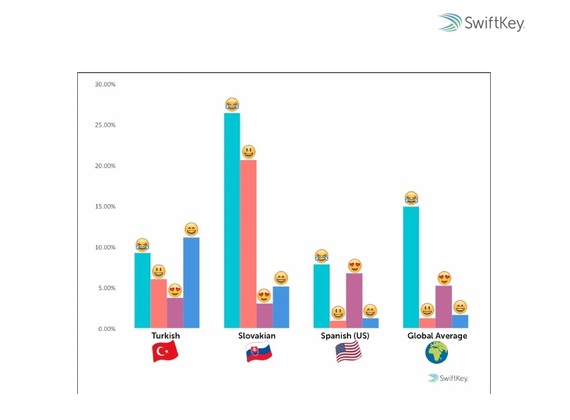Earlier this month, Oxford Dictionary announced its word of the year, which as it happens, is the term for something that makes actual language redundant: that word is "emoji". The world of texting has been truly revolutionised by the use of emojis, which allow you to communicate prolifically, and indeed with emotion, without needing to actually think of words. In fact, World Emoji Day is celebrated worldwide on 17 July!
Wordsmiths might frown at the trend, but looking at the statistics released by Swiftkey, a popular mobile technology business, sentiments towards emoji use are positive (70%) rather than negative (15%) across most cultures.
![2015-11-20-1447987894-4158953-HappyFaces.jpg]()
Happy-face emojis (Image Source: Swiftkey Emoji Report, Part 2)
Emojis around the world
According to the Swiftkey Emoji Report (see here and here), this is how users around the world are deploying the various emojis at their disposal.
• Hinglish (A desi word added by Oxford in their dictionary in December 2004) speakers lead the world in the use of the party and folded hands emojis (the latter interpreted as either praying or clapping) .
• French speakers use heart emoji more than four times the average - not so surprising, given that Paris is the city of love!
• Spanish speakers use the party time emoji 72% more than the average, a testament to the legendary Latin spirit of celebration.
• Arabic speakers the sun/hot weather emoji more than speakers of other languages, while Russian speakers favour the sun and cold weather one.
• Swedish speakers favour the bread emoji the most (after all, Sweden's breads are famous in Europe) and beer-loving Australia gets the highest score for the alcohol emoji.
Everybody has their own favourites, and we would love to hear what's yours.
By the way, do you know that Sony Pictures is developing an animated emoji movie? We hope they do a better job showing their emotions than most Bollywood actors!
![]() Like Us On Facebook |
Like Us On Facebook |
![]() Follow Us On Twitter |
Follow Us On Twitter |
![]() Contact HuffPost India
Contact HuffPost India
Also see on HuffPost:
Wordsmiths might frown at the trend, but looking at the statistics released by Swiftkey, a popular mobile technology business, sentiments towards emoji use are positive (70%) rather than negative (15%) across most cultures.

Happy-face emojis (Image Source: Swiftkey Emoji Report, Part 2)
Emojis around the world
According to the Swiftkey Emoji Report (see here and here), this is how users around the world are deploying the various emojis at their disposal.
• Hinglish (A desi word added by Oxford in their dictionary in December 2004) speakers lead the world in the use of the party and folded hands emojis (the latter interpreted as either praying or clapping) .
• French speakers use heart emoji more than four times the average - not so surprising, given that Paris is the city of love!
• Spanish speakers use the party time emoji 72% more than the average, a testament to the legendary Latin spirit of celebration.
• Arabic speakers the sun/hot weather emoji more than speakers of other languages, while Russian speakers favour the sun and cold weather one.
• Swedish speakers favour the bread emoji the most (after all, Sweden's breads are famous in Europe) and beer-loving Australia gets the highest score for the alcohol emoji.
Everybody has their own favourites, and we would love to hear what's yours.
By the way, do you know that Sony Pictures is developing an animated emoji movie? We hope they do a better job showing their emotions than most Bollywood actors!
 Like Us On Facebook |
Like Us On Facebook |  Follow Us On Twitter |
Follow Us On Twitter | Also see on HuffPost: